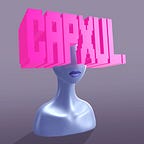Part one looked at workings of Web 2.0. Relating to media and information, it’s a top-down structure. Content and access are subject to a lot of filters and bureaucracy spanning advertising, service providers, govt agencies and the purview of tech corps like Google.
Cable News is an example of the ‘old world’ of how information gets through. State and corporate actors have oversight and control to an extent. Information is there, with reporters and journalists, but subject to a system.
In a way, this set-up compares to fiat money. How DeFi and blockchains are a different framework to fiat is also how Web 3 will differ from Web 2.
Filtering and bureaucracy are seen in how the Julian Assange trial is hidden from view — 100% to a televised audience, and obscured online. There’s an issue where a witness in the prosecution admitted to lying and colluding with the US FBI and DOJ. You have to go to this Icelandic website written in a German dialect to get the primary source (not just linked) of the story.
State media influence and the give-and-take relationship with tech giants, alluded to in part one, are the reasons. These factors are because of centralization: data centers like Amazon and Facebook, their services, location of servers, internet access, govt censorship. Bureaucratic, top-down, subject to influence.
This is a problem, and it coincides with media manipulation generally.
It does sound like something decentralized blockchain technology is ideally suited to solve. That is the basis for emerging Web 3 technologies. Just like with Bitcoin, a verifiable transparent leger could exist, tamper proof, with various properties, protocols and ownership built-in.
Dr. Mark van Rijmenam wrote about this exact dilemma with news and information subject to manipulation and falsification, and how Blockchain is the solution (on Medium). Deep Fakes is an example given of this problem.
Dr. Rijmenam cited instances where companies used Blockchain in small ways. One stands out in particular. The Ernst & Young EY Ops Chain coupled with Ethereum smart contracts to link content to “its digital representation.”
I immediately thought of NFTs, because that’s what most of them are. There’s a token with information and properties linking to an artwork like a jpeg image or mp4 video. Non Fungible Tokens are mostly on Ethereum, but also other blockchains that support smart contracts.
Personally, I don’t think linking to digital representations in itself is enough to disrupt the centralized power of Web 2.0 tech giants, but that’s the right direction to go in.
Now, I want to add two additional things (maybe to compliment the Rijmenam piece). The first is like the Earst & Young one, but easier to see what it is. The second takes it a step further.
First in March 2021, there was a very gimmicky NY Times article called ‘Buy this Column on the Blockchain!’ It talks about what NFTs are as a cultural phenomenon and artists like Beeple. Then the gimmick is that the article is minted as an NFT through the Foundation.app marketplace on the Ethereum blockchain.
However, it’s not accurate to say the NFT is for the article. It’s a scan of the newspaper, a picture of the article called a “digital original.” In other words, a linked digital representation. Just like buying a jpeg, which someone actually did for 350 eth / $712,577 USD.
A token linked to a picture is not the same as the written content. What if you could tokenize the content itself on the blockchain with who wrote it and when, transaction history and other properties?
That is exactly the concept behind Etherpoems, an NFT series created by DigitalArtChic. As instructed via this other Medium post, you can open and view the smart contract running on the Ethereum blockchain through the Etherscan website. The words of each poem are written in the actual smart contract and can be called up using the method “getPoem” (for this case) along with other properties like the author.
The information, ownership and content is secure, location independent and tamperproof in the blockchain just like transaction records in Bitcoin.
Michael Saylor described Bitcoin as giving property rights in an “open, permission-less protocol that anyone can engage with.” Decentralized. With Etherpoems, that is now true for these poems on Ethereum.
Bringing media, content and information to decentralized Web 3 from a centralized Web 2.0 with powerful gatekeepers is a huge undertaking.
As in Dr. Mark van Rijmenam’s piece, the seed is planted with these use cases. There’s nothing stopping writers, bloggers, TV personalities from distributing over smart contracts in the same way and taking it to the next level to build on this model.
It’s a start.
